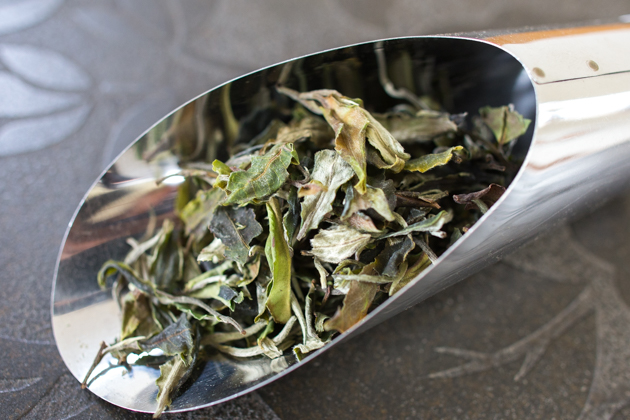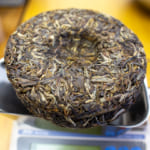- HOME >
- New Arrival at HOJO Online Shop
Gu Shu Bai Cha is now available in our store
- [2020.02.07] Posted By Akira Hojo

Ancient Tea Tree grown on high mountain
Gu Shu Bai Cha is made from the tea garden located at 2100 – 2200m in Zhenkang county of Lincang, Yunnan. The garden was owned by the manufacturer who are closely working with us every year. We have particularly selected fresh tea leaves from old tea trees. The tea trees in that garden are huge; the size of tree trunk was as bold as the waist of an adult man.
Most importantly, the tea garden is completely sustainable without any fertilizer or pesticide. Because of the high-altitude, sustainability and ancient tea tree, the tea of that garden grows very slowly. When other gardens are ready for plucking in April, the tea trees in his garden only had very tiny sprout. The first flush of spring tea from this garden was only ready in May. As tea trees spent a long time to grow, tea is very rich in poly phenols and minerals. Gu Shu Bai Cha gives a very complex, thick and long-lasting taste thanks to rich content of tea constituents.

Refreshing citrus flavour
We choose one bud and two leaves instead of one bud and one leaf to make Gu Shu Bai Cha. The single bud or one bud one leaf Bai Mu Dan contains higher ratio of amino acid and it enhances the creamy drinking sensation on palate. On the other hand, one bud and two leaves tea contains more poly phenols and taste becomes complex and rich in flavour.



It is also suitable for aging
Tea with high content of poly phenols is very suitable for aging. It is just like wine. In particular, the aged white tea without oxygen develops very sweet flavour that reminds us of fresh honey. With further aging, it also develops muscatel flavour.

White tea contains live enzymes
Unlike to other types of tea, white tea contains live enzymes. It is because in making white tea, there is no heating process. Traditionally, after tea plucking, the fresh tea leaves are spread on bamboo mat and gradually dehydrated. It is called withering process. During withering process, tea undergoes moderate oxidation and it develops floral flavour. For making oolong tea or black tea, tea leaves have to undergo pan-frying process in order to inactivate enzymes. As for white tea, the withering and drying process takes place at the same time and tea has never heated during the whole process. That is why white tea contains live enzymes.


It gives excellent result in cold water brewing
As white tea contains live enzyme, it catalyses moderate oxidation when tea is brewed in hot water. You may observe some changes of leaf colour from green to beige during brewing with hot water. The flavour of white tea brewed in hot water is relatively fruitier.
If you wish to maintain the fresh green colour of tea leaf and would like to enjoy very fresh floral flavour, please try brewing white tea in cold water. Usually we use 5g of tea leaf in 1.5 to 2 Litres of water. You will get a better result in flavour if you use the water that is boiled once and cooled down. All you have to do is to steep tea leaf in cold water and leave it in a refrigerator for more than half a day. Usually, children also love to drink cold water brewed white tea.
Related Articles
How to get the latest update on HOJO?
1. Follow Twitter, 2. Click "Like" on Facebook, and 3. Subscribe in newsletter. You can have the latest tea news from HOJO.
 Subscribe the Newsletter to enjoy the privileges
Subscribe the Newsletter to enjoy the privileges- You may receive a free sample upon purchase, or you may have the priority to purchase special products. So please remember to subscribe our newsletter as well as the social network.
- New Arrival of Akitsu Mumyoi and Nosaka Rough Clay Teapot
- A wide selection of teaware by Watanabe Tozo, a Sado-based artist of Mumyoi-yaki, has just arrived. This time, …
- Mang Fei Ripe Pu-erh Tea 2023 – Small-Batch Production from a Renowned Region
- Mang Fei Ripe Pu-erh Tea 2023 is now available. This is one of the highest-quality ripe pu-erh teas among our …
NEW ARTICLES
 Development of Firewood Roasted Hojicha Using Naturally Grown Tea from Yunnan
Development of Firewood Roasted Hojicha Using Naturally Grown Tea from Yunnan- We are currently staying in Yunnan Province for tea production. As the season nears its end, tea trees with pa …
 Exploring the Food Culture of Yunnan: Where Minority and Sichuan Cuisines Meet
Exploring the Food Culture of Yunnan: Where Minority and Sichuan Cuisines Meet- We are currently staying long-term in Yunnan Province for spring tea production. On rainy days or when there i …
 New Arrival of Akitsu Mumyoi and Nosaka Rough Clay Teapot
New Arrival of Akitsu Mumyoi and Nosaka Rough Clay Teapot- A wide selection of teaware by Watanabe Tozo, a Sado-based artist of Mumyoi-yaki, has just arrived. This time, …
 Managing Yunnan White Tea — Insights from the Field
Managing Yunnan White Tea — Insights from the Field- Since March 25, we have been in Yunnan Province, fully engaged in the production of white tea. In this column, …
 Mang Fei Ripe Pu-erh Tea 2023 – Small-Batch Production from a Renowned Region
Mang Fei Ripe Pu-erh Tea 2023 – Small-Batch Production from a Renowned Region- Mang Fei Ripe Pu-erh Tea 2023 is now available. This is one of the highest-quality ripe pu-erh teas among our …
 Yunnan Tea Trends 2025: Insights from the Fields
Yunnan Tea Trends 2025: Insights from the Fields- Since March 25, we have been in Yunnan Province. We will stay here until May to conduct tea production, packin …
 Why Do Some Teas Taste Astringent? Exploring the Causes and Mechanisms of Astringency
Why Do Some Teas Taste Astringent? Exploring the Causes and Mechanisms of Astringency- Tea can range from having no noticeable astringency to possessing a very strong one. What causes this astringe …
 The Impact of Heat Sources on Tea Flavor
The Impact of Heat Sources on Tea Flavor- It is widely recognized that the material of a kettle plays an important role in shaping the taste of water fo …
 New Release of Tang Li Shan Ripe Pu-erh Tea 2023
New Release of Tang Li Shan Ripe Pu-erh Tea 2023- We have released the 2023 edition of Tang Li Shan Ripe Pu-erh Tea. Tang Li Shan refers to a mountain located o …
 The New Release of Dong Shan Raw Pu-erh Tea 2023 and Jasmine Silver Needle
The New Release of Dong Shan Raw Pu-erh Tea 2023 and Jasmine Silver Needle- We have released Dong Shan Raw Pu-erh Tea 2023 and Jasmine Silver Needle. Dong Shan Raw Pu-erh Tea 2023 We hav …
Category
- New Arrival at HOJO Online Shop
- Featured Articles
- Newsletter
- Types of Tea
- Origin of Tea
- Teapot and Tea Equipment
- Tea Column
- How to enjoy tea
- Tea Processing
- How to choose quality tea
- Tea constituents and functional effect
- Safety of Tea
- Foods
- Tea Business Operation
- Hobby and Outdoor Activity
- Ranking of Tea
- Video
- FAQ
- Media Release
Profile

- AKIRA HOJO
- I invite you to experience my tea selections.I was born in Nagano, Japan. In university, I studied agricultural chemistry, and I have the master degree in food science. I worked in Japanese food industry for 10 years. I involved in R&D, QC and QA. As a factory manager, I implemented ISO9000 series and managed the factory.
- The Art of Tea Magazine
- We posted the article on “The Art of Tea Magazine No.9, the magazine is published in Taiwan. We featured …
- New Straits Times
- The Malaysian National Newspaper, New Straits Times featured HOJO Tea on 17-Oct-2007.
Shop Info

Address:Lot No. T-215, 3rd Floor, The Gardens Mall, Mid Valley City, Lingkaran Syed Putra, 59200 Kuala Lumpur
Tel: +603-2287-4537
Business Hour: 10am to 10pm














